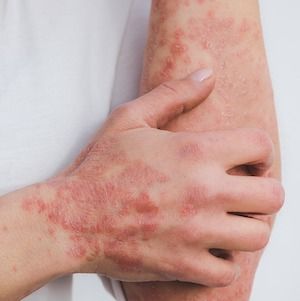News
Article
Biologic Therapy Improves Metabolic, Inflammatory Profiles in Patients with Psoriasis
Author(s):
Results showed significant improvements in serum HDL, CRP, and ESR after treatment with biologic therapies
Credit: Pixabay

Findings from a longitudinal case-control study and prospective study showed biologic therapies improve the overall metabolic and inflammatory profiles of patients with psoriasis.
Treatment with biologics significantly improved high-density lipoproteins (HDL), C reactive protein (CRP), and erythrocyte sedimentation rate (ESR) levels at 6 months, also decreasing the number of patients meeting the diagnostic criteria for metabolic syndrome and chronic inflammation compared to baseline.1
“To the best of our knowledge, this is the first study in the reported literature that demonstrates a significant reduction in the number of psoriatic patients presenting diagnostic criteria for metabolic syndrome after biologic therapy,” wrote Teodora Larisa Timis, of the department of physiology at Iuliu Hatieganu University of Medicine and Pharmacy in Romania, and colleagues.1
More than 8 million people in the US have psoriasis, frequently treated with creams and ointments. However, more severe cases sometimes require immune therapy medications like biologics to prevent autoimmune reactions, and the impact on metabolic syndrome and chronic inflammation remains unclear.2
Investigators sought to assess the impact of biologic therapies on the metabolic and chronic inflammatory profiles of patients with psoriasis, also comparing the prevalence of metabolic syndrome and chronic inflammation between psoriasis patients and non-affected controls. To do so, they enrolled 106 patients with psoriasis and 106 patients without psoriasis and matched them according to gender, background, and age category.1
In the psoriasis group, 66 (62.26%) patients were male and the mean age was 49.5 (Standard deviation [SD], 14.14) years. In the control group, 61 (57.54%) patients were male and the mean age was 43.93 (SD, 14.11) years.1
Psoriasis Area Severity Index (PASI) and Dermatology Life Quality Index (DLQI) were determined for all participants and reevaluated among psoriatic patients after 6 months of treatment. Biological samples including abdominal circumference, arterial blood pressure, dosing serum triglycerides (TG), HDL, glucose, ESR, and CRP were obtained from all cases and controls. The presence of comorbidities such as arterial hypertension (HTN), type II diabetes, and psoriatic arthritis was also noted.1
Clinical features, risk profiles, and individual preferences were used to establish the treatment with ixekizumab, secukinumab, guselkumab, certolizumab, ustekinumab, risankizumab, or adalimumab. In total, 37 (34.91%) patients received ixekizumab, 21 (19.81%) received secukinumab, 5 (4.72%) received guselkumab, 5 (4.72%) received certolizumab, 7 (6.6%) received ustekinumab, 16 (15.09%) received risankizumab, and 15 (14.15%) received adalimumab.1
Investigators performed nominal logistic regression to test for correlations between PASI scores, DLQI scores, and the diagnostic parameters for both metabolic syndrome and systemic inflammation. PASI was statistically significant in the correlation with CRP (P < .000), with a tendency for significance between PASI and abdominal circumference (P = .08). Investigators noted statistical significance for the correlation between DLQI and abdominal circumference (P = .008), ESR (P = .003), and CRP (P < .000).1
Investigators used the Related-Samples Wilcoxon Signed Rank Test to examine differences between the initial values and those at 6 months of therapy, with results showing a statistically significant increase in abdominal circumference (P = .002). Investigators also pointed out a significant difference in HDL, with 58.49% of patients having a greater value at 6 months than at initial evaluation (P < .001).1
Further analysis with the Related-Samples McNemar Change Test verified the differences in dichotomic value distribution for the presence of HTN, obesity, metabolic syndrome, and inflammatory syndrome at the 2 temporal points. Most patients did not meet the necessary criteria for metabolic syndrome at 6 months, with the difference between the two points in time being statistically significant (P < .001). Additionally, the number of patients no longer meeting the criteria for chronic inflammation was markedly higher and the difference between the 2 temporal points showed statistical significance (P < .000).1
“The results presented suggest that biologics are effective in the amelioration of the metabolic and inflammatory profiles of psoriasis patients, significantly reducing the number of patients eligible for both conditions. Biologics also proved effective in ameliorating HDL, CRP, and ESR levels,” investigators concluded.1 “We are optimistic in that this research may help contribute to the developing body of knowledge regarding the global efficacy of biologics vis-à-vis the metabolic and inflammatory profiles caused and exacerbated by psoriasis.”
References:
- Timis TL, Beni L, Florian IA, et al. Prevalence of metabolic syndrome and chronic inflammation in psoriasis before and after biologic therapy: a prospective study. Med Pharm Rep. 2023;96(4):368-383. doi:10.15386/mpr-2631
- Cleveland Clinic. Psoriasis. Diseases & Conditions. September 15, 2022. Accessed November 20, 2023. https://my.clevelandclinic.org/health/diseases/6866-psoriasis#management-and-treatment




